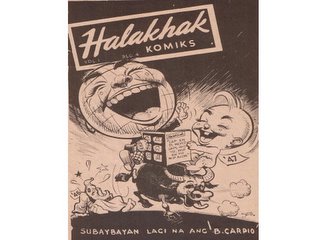Onomatopaeic for guffaw, the Halakhak was published out of the initial efforts of Isaac Tolentino and Atty. Jaime Lucas.
At the time of the Halakhak's birth, the Philippines was a devastated nation struggling to rise from the ashes of war. Most of the local publications were still closed because of the shortage of paper. Hence, many cartoonists were temporarily out of work. Understandably, reading cartoons at that critical time seemed a luxury, so that the few newspapers who managed to publish erratic issues carried only news and statements from the government.
One day, an unemployed cartoonist (of the former T-V-T) by the name of Isaac Tolentino was wandering through Azcarraga Avenue (now Claro M. Recto) in search of work. Tolentino chanced upon the newly-established Universal Bookstore owned by Atty. Jaime Lucas.
Atty. Lucas immediately recognized Tolentino because he was a follower of the latter’s satirical cartoons in the Philippines' Free Press. In the ensuing conversation, Tolentino casually suggested to Atty. Lucas the idea of publishing "funnies", a regular comic book, after all, would it not be timely now to make people laugh after the grim destruction brought about by the recent war?
At that time, no one had thought of publishing a regularly-issued comic book before. Since he was an admirer of Tolentino, Atty. Lucas agreed on the spot to publish comic-magazine which they agreed to call Halakhak.
In the next few days, Atty. Lucas gathered enough funds-mostly from his personal money and loans from banks-for the initial printing.
For his part, Tolentino gathered some of his pre-war cartoonist friends, which included the brothers Tony and Damy Velasquez, J.M. Perez, Elmer Abustan, Gene Cabrera, Francisco Coching, Liborio Gatbonton, Fred Carrillo, Francisco Reyes, Jose Zabala-Santos, Hugo Yonzon, Larry Alcala, Pedro Coniconde and Lib Abrena.
Since Tolentino and Atty. Lucas had no printing press, they commissioned Carmelo and Bauermann Company to print the 10,000 initial issues of Halakhak Komiks #1 in 1946. They established the Halakhak's office at #665 Evangelista, Quiapo Manila.

Issue #4 of the Halakhak Komiks. Cover art by Jose Zabala-Santos
Included in the Halakhak were the following comic strips:
Mga Hindi Sukat Akalain, Geslani- Isaac Tolentino
Eto na si Tibo- Gene Cabrera
Si Pino- Jose Zabala-Santos
Talahib- Francisco Reyes
Doon daw sa Langit- Liborio "Gat" Gatbonton
Bulalakaw- Francisco V. Coching
Kidlat- Jesse Santos and Damy Velasquez
Kasikoy- A. I Roullo
Binong Lambanog- Nolasco "Noly" Panaligan
Enyong Bohemyo- Cris Caguintuan
Teryong Alat- Hugo Yonzon (Father of Hugo Yonzon III of Mango Comics)
Indo- Maning de Leon
All in all, the Halakhak had 42 pages and initially priced at 25 centavos (then about the price of one 8oz Coca-Cola). The first issue was printed on a smaller than usual size, about the size of a half of long bond paper, this is because of the shortage of paper, as already mentioned. In its later issues, however, it was made into the regular sized komiks, and was priced at 40 centavos.
Initially,the company prospered but in its later issues, it began to have business troubles; it never recovered stability and the Halakhak lasted only ten issues; the company closed shop after that, financially ruined.
The ultimate reason why Halakhak failed? Uncollected debt.
Since there was no precedent as to how to run a komiks business, Atty. Lucas and Isaac Tolentino failed to understand its economics. Publishing comics for nationwide distribution required an effective distribution network, something Atty. Lucas and Tolentino did not have. They relied heavily on agents who advanced copies without payment. This eventually became the ultimate problem since many agents did not pay their obligations, even when the komiks had been sold out. Since there were only few advertisers in the Halakhak, these were not enough to cover the fees for artists, let alone pay for printing expenses. Atty. Lucas was forced to close the company.
Thus, the Halakhak, which meant laughter, and was highly successful in giving laughter to its readers, failed to give laughter to its publisher.
 Issue#8 of the short-lived Halakhak Komiks. Two issues later, it closed publications.
Issue#8 of the short-lived Halakhak Komiks. Two issues later, it closed publications.

5 comments:
jan pala na-inspired si Hugo Yonzon III to adapt the title for his Mwahaha komiks...hehe
May xerox-copy din ako ng Pinoy ni Zabala-Santos. Siguro mga 8 pages din yun, ang wala lang is yung lumabas dun sa Philippine Comics Review.
Oo nga no! Di ko na-realized agad yun ah. Halakhak at Mwahahah ay pareho lang! :)
Ang lungkot naman ng kwento ng Halakhak. Yan ang isa sa mga gusto ko makuha one day, yang complete set ng mga Halakhak Komiks. It's a significant yet tragic part of our comics history.
Gerry: Talagang mahirap na makahanap pa niyang ganyang komiks. Napakamahal pa kung meron mang magbenta. Pero sure ako there might be hidden somewhere that just needs to be discovered. :)
naging teacher ko sa cartooning si mr. isaac tolentino sa feati university noong 70"s.siya pala ang nagsimula ng halakhak komiks. kasabay niyang nagtuturo ng cartooning noon sa feati (Fine Arts) si GAT (Liborio Gatbonton).
Post a Comment